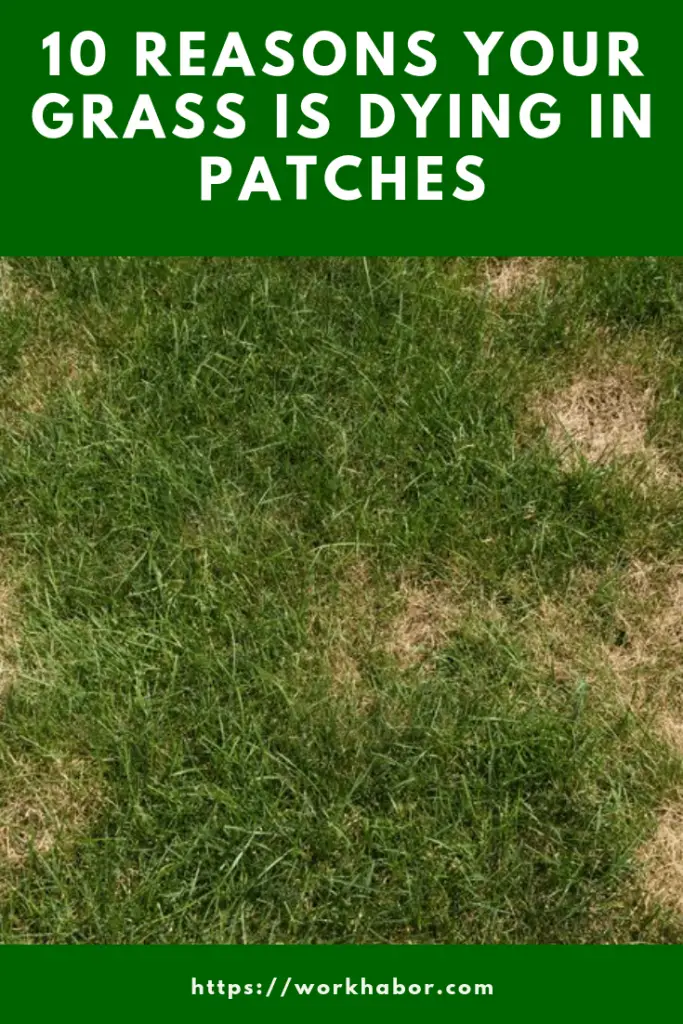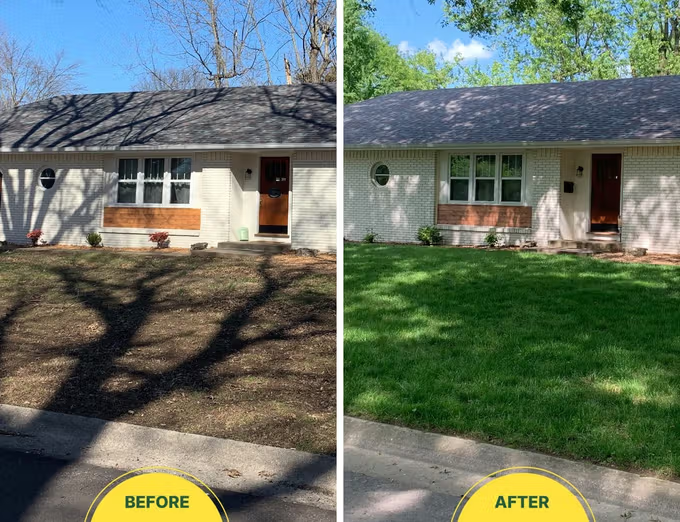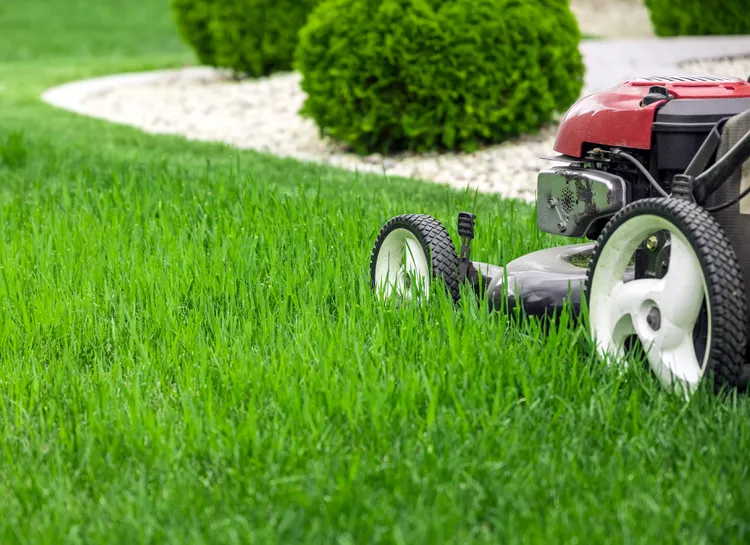10 Reasons Your Grass Is Dying In Patches
Last Updated on October 29, 2020 by Duncan
We all want a healthy lawn. We mow, fertilize, water, scarify, fork, control weeds, and many other things to make it possible.
Unfortunately, with all the efforts, patches develop on the lawn.
It’s hard to tell the patches’ cause, but with a little investigation, you can know. Here are some of the most common reasons your grass is dying in patches:
#1: There are grubs in the soil
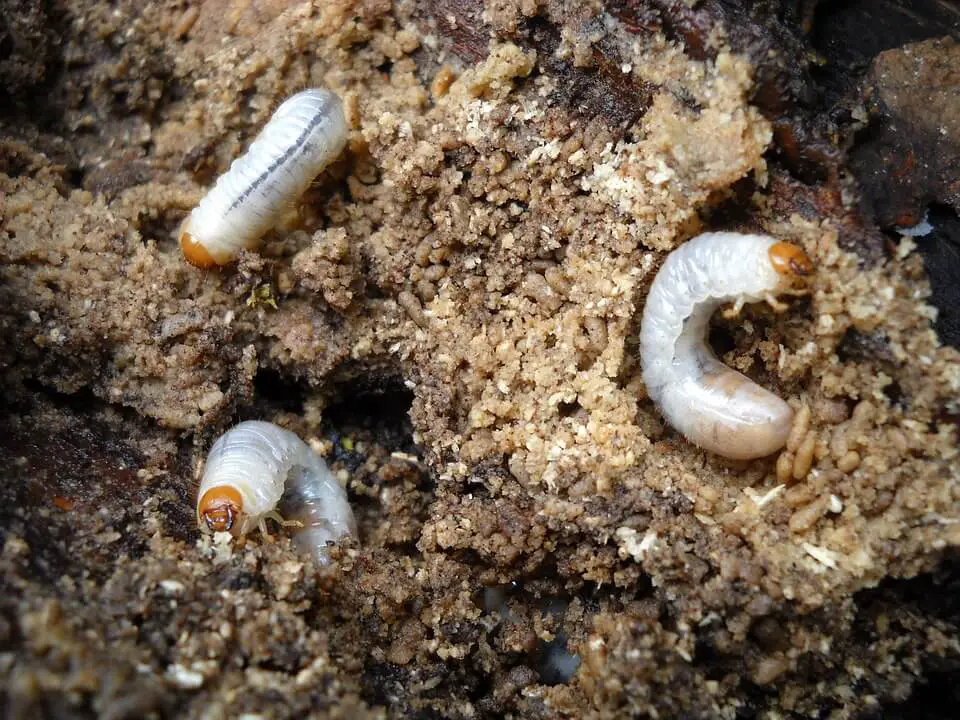
The C-shaped pale cream grubs with blown heads damage the grass by eating the roots, leading to small brown patches that eventually widen, covering the entire lawn.
Patches as a result of grub infestation have a sponge feeling and roll up when raked. This is due to root damage.
To determine whether the patches are due to grubs, dig out 20 cm X 20 cm sods in different areas.
If you find more than 5 grubs in the sods, the damage is definitely due to grubs.
For you to fix the problem, you need to kill the grubs. To do this, you need to use a grub killer. You can use a scan mask or Ortho.
You can repair the damage at any time of the year, but you are better off doing it through fall. To repair the existing brown spots, rake the affected areas to remove the dead grass.
You should then apply the grass seed that is designed for the area.
#2: The dogs have peed on the grass
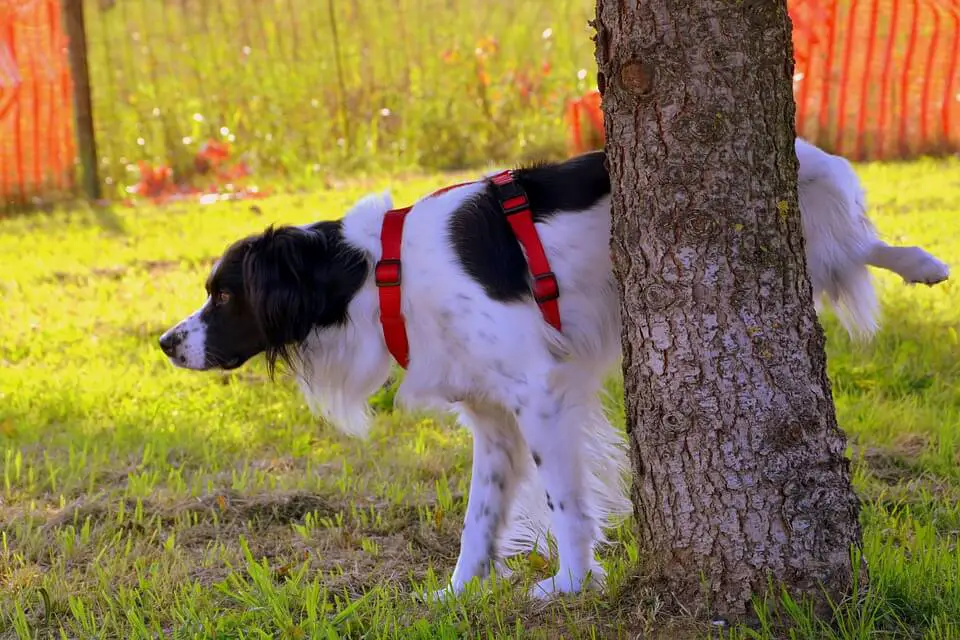
Dog urine contains high levels of nitrogen that burns the grass leading to brown patches. Patches brought about by dog urine are circular and yellow in color.
Sometimes you have a bright green ring around the edges where the diluted nitrogen in the urine acts as a fertilizer.
For you to fix this problem, you need to ensure that no pets get to the lawn. You can use animal repellent in the treated areas to deter pets.
Since the grass is dying due to high nitrogen levels, you should reduce nitrogen fertilizers’ application.
#3: You are mowing improperly
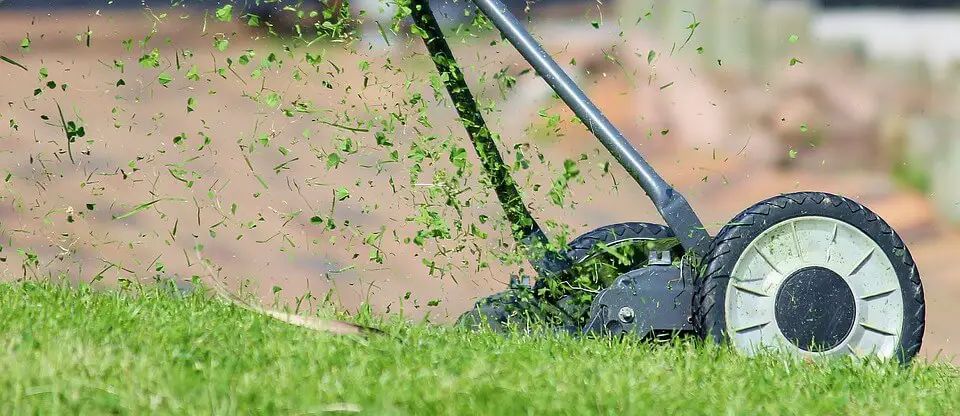 It’s easy to damage your lawn when you mow the lawn incorrectly. One of the mistakes you can make is using a dull lawnmower.
It’s easy to damage your lawn when you mow the lawn incorrectly. One of the mistakes you can make is using a dull lawnmower.
Dull lawnmower blades tear grass, causing damage and gradual death of grass.
For you to avoid damage due to a dull lawnmower, you should sharpen the lawnmower blades before you start mowing.
After mowing, inspect the grass to see whether it’s cutting the grass properly.
Besides using dull lawn mower blades, you can also damage the grass by setting the mowing blades too low.
By doing so, you end up cutting the grass too short, causing damage to the grass.
To fix this problem, you only need to raise the lawnmower blades. Never mow off more than 1/3 the height of the grass.
If there are lumps on your lawn, first smoothen them out. You need to dig up the sod then remove some of the soil underneath, after which you should replace the sod.
#4: Your grass is affected by lawn diseases

Lawn grass can be affected by a wide range of lawn diseases. The most common ones being:
Red thread
When your lawn has this disease, it tends to have mottled patches of yellow to brown and dead grass.
The edges of the patches may have red/pink coloration of red spores. On touch, the affected grass has a slimy feel.
For you to fix the problem, you need to kill the spores of the fungus using spectracide.
Brown patch
Symptoms of the fungal infection include: patches of yellow to brown and dead grass. The patches often grow up to 1 meter in diameter. The roots of the grass often turn black.
Just like when killing the other fungus, you need to use a fungicide that will kill the fungus’ spores.
Chinch bugs
Chinch bugs are common in warm-season lawns. You will often find them in hot sunny patches beside the driveways and sidewalks.
For you to fix the issue, you need to scrutinize the lawn. Take a look at your shoes as you walk through the grass. If the lawn has pests, you will spot small black and white adults.
The pests are resistant to many pesticides, but few have been proven to kill them.
Other diseases that affect the lawn include:
- Dollar spot: Characterized by small circular brown patches
- Fusarium: Features circular orange/brown patches that are 5-30 cm in diameter
- Snow mould: These are circular dead patches with pink tinge around the edges
- Pythium greasy spot: The grass is slimy and turns brown to grey and sometimes to black.
#5: Your lawn has poor growing conditions
:max_bytes(150000):strip_icc():format(webp)/GettyImages-182175267-5822918c3df78c6f6a9b3c7b.jpg) There is no way your lawn will have lush green grass while it has poor growing conditions. Some of the issues your lawn might be having include:
There is no way your lawn will have lush green grass while it has poor growing conditions. Some of the issues your lawn might be having include:
Poor soil
Soil quality varies on the lawn. Poor soil occurs in patches leading to brown, bare areas or moss. For you to fix this problem, you need to push a screwdriver into the soil.
If you have problems pushing it, the soil is most likely compacted.
You should try aerating and top dressing the area to incorporate organic matter into the soil.
Buried debris
If you have an old piece of buried lumber under the grass, you are bound to have patches on the lawn.
With a screwdriver, poke around the affected areas and see if there is anything underneath the sod.
Soil erosion
Water runs off slopes, carrying seeds and young shoots with it. It leaves the bare ground or dried out areas behind.
For you to fix the area, you need to aerate the lawn to increase water absorption. If the slope is steep, consider building terraces. You can also plant groundcover to hold the soil.
Tree roots
Large trees or shrubs near your lawn draw a lot of water and nutrients from the grass leading to dead spots.
If you can’t remove the trees, consider undertaking mulching. You can also naturalize the areas under the trees and shrubs.
Drought
When it’s dry, the grass might not be receiving enough water to grow healthily, leading to dry, compacted spots.
To get over this problem, keep an eye on the dry, sunny spots. If you have water, consider irrigating the lawn. When doing it, ensure that the entire lawn is thoroughly and evenly watered.
#6: The grass has gone dormant
:max_bytes(150000):strip_icc():format(webp)/close-up-of-a-dried-lawn-1073058046-5c5dce3e46e0fb0001dcd06f.jpg)
It’s common for cold-season lawns to go dormant during summer and warm-season lawns to go dormant during winter.
If your lawn is like many others, you have a mix of grasses; hence it’s common for the lawn to develop patches as some of the grasses go dormant while others stay green.
Seasonal dormancy is normal, and you shouldn’t be worried when it comes along.
While this is the case, ensure that the lawn is healthy and strong to prevent unnecessary browning.
#7: You have left items on the lawn for too long
Constant use and leaving of items on the lawn prevent light from getting to the lawn leading to brown or dead patches.
The soil in these areas also tends to be compacted, which prevents the air from getting to the grass’s roots.
To fix this issue, remove the items that might prevent the grass from receiving the sun rays.
If there is a lot of thatch in the area, remove the dead grass material by raking the dead grass using a mechanical de-thatcher.
You should then go ahead and aerate the soil. You do this using a garden fork. Insert the fork into the soil to open up the soil.
If you don’t want to use a fork, consider using a mechanical lawn aerator. You can rent or buy one from your local store.
#8: You are leaving too many clipping on your lawn
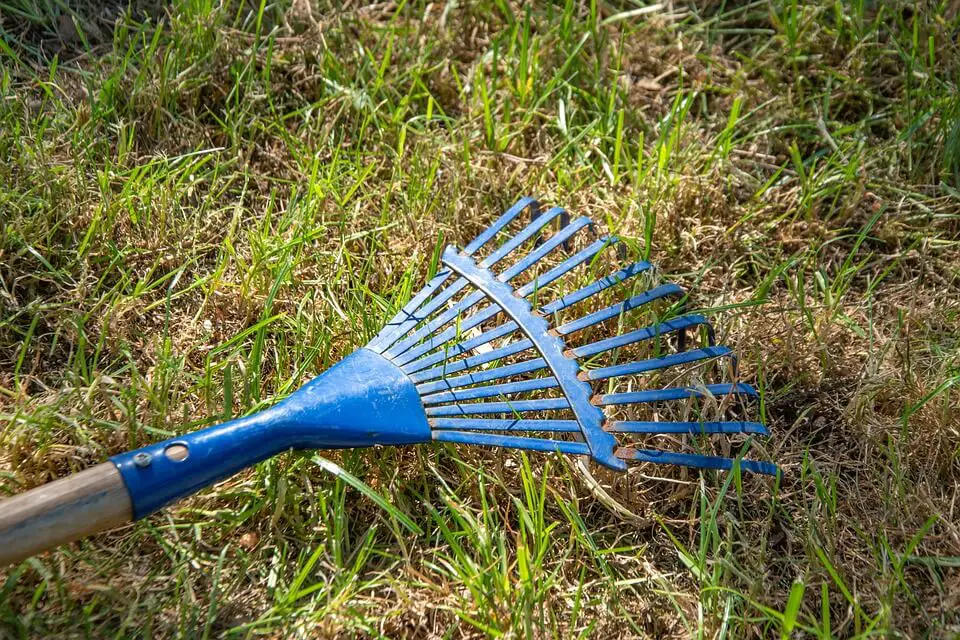
Mulching keeps the grass green, but when you overdo it, you slowly kill it. Leaving too many clippings covers the grass, creating conditions for the grass to flourish.
Mulch only when you are trimming the lawn. Cutting small amounts of grass off the grass’s top produces short clippings that fall through the grass to the soil surface.
Since they are small, they are easily broken down and incorporated into the soil.
#9: Your grass has a nutrient deficiency
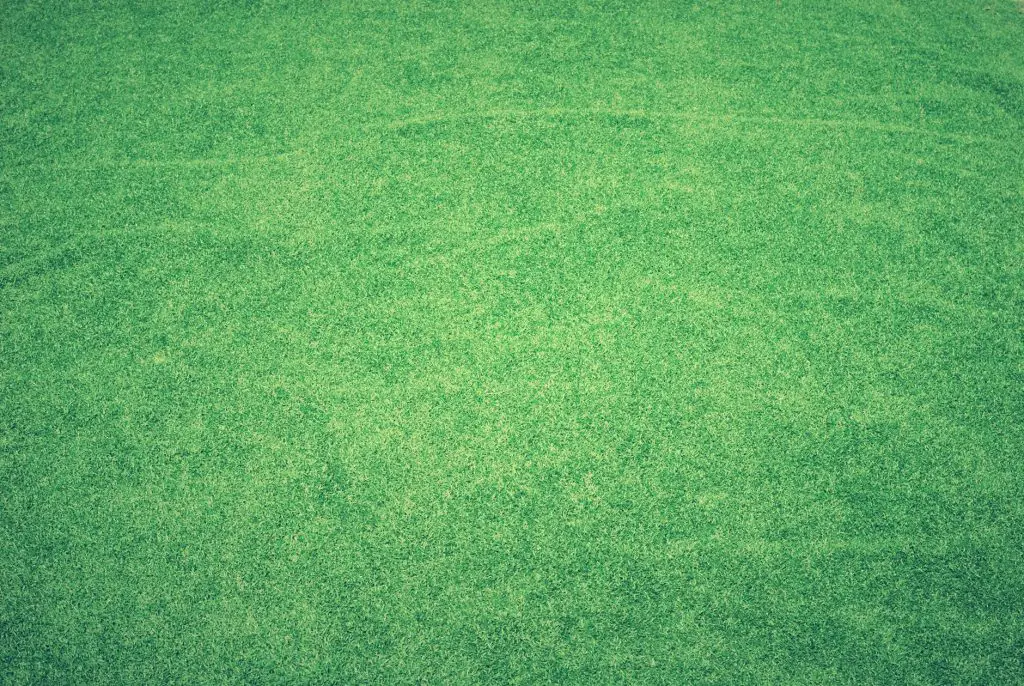 Lawn patches might also be brought about by a nutrient deficiency that causes the grass to stress, yellow, and even die off.
Lawn patches might also be brought about by a nutrient deficiency that causes the grass to stress, yellow, and even die off.
Your lawn can be having a wide range of nutrient deficiencies, with the most common ones being:
- Nitrogen deficiency: Here, the lawn goes pale and patchy
- Potassium deficiency: You will experience wilting and discoloration of the grass
- Phosphorous deficiency: You have slow growth, and the lawn will have a burnt look
- To fix the issue, take your soil for testing. After testing, the professionals will guide you on the best fertilizer you should apply on the lawn.
#10: You have applied too much fertilizer
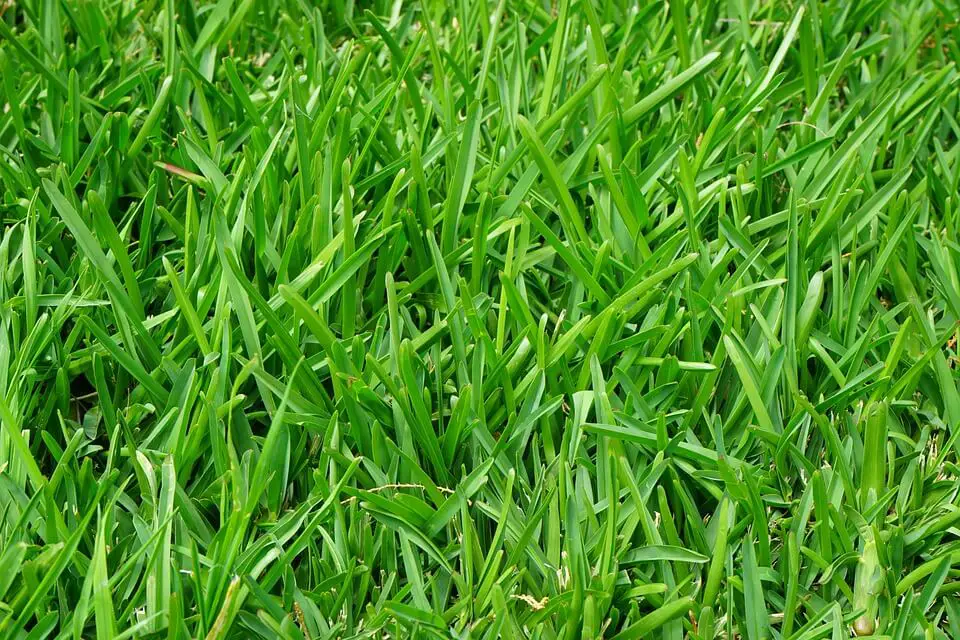 Lawn fertilizer aims to keep the lawn lush and green, but when you over apply it, you burn the grasses leading to discoloration and even death of the grass.
Lawn fertilizer aims to keep the lawn lush and green, but when you over apply it, you burn the grasses leading to discoloration and even death of the grass.
When you over apply nitrogen fertilizer, the lawn tends to brown off.
Over application of iron, fertilizer leads to the blackening of lawn grass.
You should be cautious when applying fertilizer on your lawn. Always follow the manufacturer’s instructions.
Most of the burns result from using high NPK fertilizer. To be on the safe side, use low NPK fertilizer.
